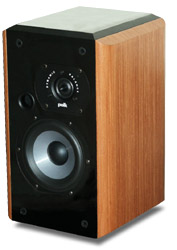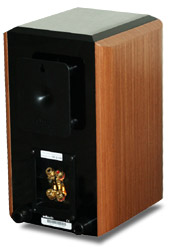Polk Audio LSi7
Loudspeakers
 When you buy
speakers that cost less than $500, the price point itself eliminates many choices. This
isn’t to say that all inexpensive speakers are the same -- far from it -- but in
general, the best are two-driver designs in relatively compact, bookshelf-sized
enclosures. When you buy
speakers that cost less than $500, the price point itself eliminates many choices. This
isn’t to say that all inexpensive speakers are the same -- far from it -- but in
general, the best are two-driver designs in relatively compact, bookshelf-sized
enclosures.
As you approach $1000, you have more options. The designers
have the resources to use different drivers and enclosures. And customers often equate
more expensive speakers with bigger speakers. Above the $500 price range, the number of
large, multi-driver, floorstanding speakers to choose from increases. But bigger doesn't
necessarily mean better.
Enter Polk Audio’s diminutive $810-per-pair LSi7
loudspeakers, which seem the same size as many sub-$500 bookshelf speakers, but which
offer performance that can better that of many costing more than $1000.
But that probably doesn't come as too big a shock -- after
all, everybody knows there's many a surprise inside a small package.
Description
At the heart of the LSi7 is a 5.25"
polypropylene woofer that has been "foamed" with air. The tweeter is Vifa’s
unique-looking XT25, a driver used in a number of high-quality designs. Krell’s
expensive $10,000 LAT-2 has it, but so too does nOrh’s $995 SM 6.9 -- the Polks are
the lowest-priced speaker incorporating it that I’ve encountered. The crossover
frequency between the two drivers is 2.4kHz.
The tweeter is offset to one side of the woofer, making the
speakers "mirror imaged." In a normal setup you would position the tweeters on
the inside.
The 14.25"H x 8.125"W x 10.25"D cabinet is
crafted with jewel-like precision. It’s smaller than many speakers at this price, but
it’s built to a high standard.
There is real-wood veneer on the sides and glossy
"lacquer" panels on the top and bottom -- sure signs that you are getting out of
the under-$500 speaker camp where wood-like vinyl veneer rules. At this price, it is
normal to find real-wood veneers, but I like the way Polk took it one step further by
eliminating all the 90-degree corners. It’s no longer just a rectangular box with a
nice finish. It has sides and angles and just a little more sex appeal than most competing
designs.
But it’s not all looks. The cabinet is elaborately
designed around a core enclosure built from .75"-thick MDF. Then, those good-looking
panels are added to the sides and top. All this adds up to an exceptionally solid, dense
little speaker that weighs in at 21 pounds. The side walls end up being 1.5" thick! I
haven’t seen a more solidly constructed cabinet at anywhere near the LSi7's
price, and it’s a sure-fire reason these speakers cost closer to $1000 than
$500.
Around back are dual sets of binding posts that allow for
biwiring (something Polk recommends doing), not to mention Polk’s patented Power
Port.
The Power Port is neat. It’s basically a large plate
suspended away from the back of the cabinet with a flared cone that goes directly into the
rear-firing port hole. Polk says the cone and plate increase the port’s efficiency
and reduce the air's turbulence as it travels out. It also directs the air to sides of the
cabinet, which makes for easier placement closer to rear walls. And, if you ever want to
mount the speaker on the wall -- whether for regular listening or as a surround-sound
speaker -- the LSi7s have predrilled holes and footers on the rear panel, so that
the speaker can be hung up easily.
Polk says the -3dB point of the LSi7 is 53Hz, the
sensitivity is 88dB, and the nominal impedance is 4 ohms. While the sensitivity is
average, the impedance is a little bit lower than the norm and it may give some amplifiers
some grief.
The LSi7s need some current to make them really
sing. I drove them with both Nakamichi's AV-10 surround-sound receiver and Arcam’s
FMJ A32 integrated amplifier. Both of these put out 100Wpc into 8 ohms and, while not
necessarily powerhouses into low-impedance loads, they are capable of driving 4-ohm
loads quite easily. I also tried these speakers with one amplifier that doesn’t like
low-impedance loads. Sure enough, it struggled with them, particularly in the bass.
Correct amplifier matching is critical.
Sound
To best appreciate the LSi7, it helps if you
understand its intent. This speaker is not for dance-club partiers, or for those who think
bigger is better. Big, bad bass is just not its thing. Instead, it's a small, exquisite
speaker that can play with exacting precision. It’s designed for listeners who value
refinement and detail over sheer output capability -- and it will perform best in smaller
rooms with listeners seated fairly close to it.
The first thing I noticed about this speaker was its clear
and defined midrange. The LSi7s are smooooth, but, at the same time,
marvelously textured and detailed. Male vocals don’t have an ounce of chestiness or
overhang. Even playing music as weighty and dark as Leonard Cohen’s Ten New Songs
[Sony 85953], the LSi7s sound razor-sharp. I’ve heard much more expensive
speakers than the Polks get bogged down with this recording, so I give the LSi7s
top marks here.
Female vocals soar with pristine clarity, lacking even the
slightest hint of excessive sibilance. Jewel’s This Way album [Atlantic
83519], recorded with close-miking on her voice and guitar, can sound particularly harsh
if the speaker is not well behaved. The LSi7s, though, render it with an
exquisitely refined top end that shows plenty of air and detail. The vibrancy of the
guitar is richly sketched and most of the detail you want flies through. Boxy colorations
that are quite common in speakers priced under a grand are completely absent.
Recordings like the choral and orchestral music on The
Mission's soundtrack [Virgin 90567] display this speaker’s outstanding
soundstaging and imaging capabilities. Both the width and depth of the stage are
exemplary. Dimensionality of the individual instruments and singers is outstanding. The
level of detail conveyed is amazingly complete -- not quite up to the very best
speakers you can buy, but certainly fine enough to put this one at the top of its class.
Close your eyes and you'll be staggered by all the detail and dimensionality before you;
open your eyes and you'll be startled by the size of the Polks.
Given the strong midrange performance and the high level of
detail, it’s not surprising that the LSi7s do very well on movie dialogue and
sound effects, too. I wasn’t feeling well for a couple days this month, so I laid low
with some rental DVDs, including Jacob’s Ladder, one of my favorite
horror/suspense films. I set up a simple stereo system using only a pair of LSi7s
and my regular TV monitor (getting "TV out of the box" as
onhometheater.com’s Wes Phillips likes to say). Voices were crystal clear and the
minute details were easy to pick out. Yes, deep bass was missing -- something I’ll
get to in a moment -- but for a small-system setup, it was wonderful. Add a sub and you
may be in heaven.
Perhaps someone will use the LSi7s in a simple setup
like I did, but more than likely they’ll look to use them in a complete home-theater
system with the other LSi models that are available. That’s part of the beauty
of this series. Polk has larger speakers than this one, plus a center-channel speaker and
a surround model. This variety allows a simple system to expand into a full multichannel
system in steps (or you could do it all at once). I would say that given the strong
performance of these little gems, the complete system is worth investigating.
Now, about that bass
What bass the LSi7 does reproduce, it does
well. It’s tight and detailed and it hits with what I call "micro slam."
It’s not going to shake the room, but you will sense the whump. In my room, with
careful setup and wall reinforcement, the speaker went down to 60Hz or so before stepping
aside. That’s fairly low, but if you play the opening track from the Cowboy
Junkies’ The Trinity Session [RCA 58568], you won’t hear that really deep
rumbling that can pressurize a room. I suspect that the little LSi7 rolls off fast
and doesn’t drag itself out. This is a pleasant contrast to some small speakers that
struggle and make all kinds of awful sounds before they decide that enough is enough. The
LSi7 remains quite steadfast and simply says "no" when it reaches its
limits.
 If you’re a bass fanatic, chances are the LSi7 without a subwoofer
won’t be enough. Paradigm's $519-per-pair Monitor 5 speakers go solidly below 50Hz
and have output capability that can fill much larger rooms -- but they also sound quite
different. While $810 buys you a lot in the LSi7, it can’t get you everything.
I can live without deep bass providing it does go low enough to not sound thin or
lightweight. The speakers must also deliver something noteworthy in other areas. The LSi7s
have just enough bass to allow me to hear most bass guitar lines clearly without
making the music sound wimpy, but not enough to reproduce the true sense of heft and slam
of an upright bass. If you’re a bass fanatic, chances are the LSi7 without a subwoofer
won’t be enough. Paradigm's $519-per-pair Monitor 5 speakers go solidly below 50Hz
and have output capability that can fill much larger rooms -- but they also sound quite
different. While $810 buys you a lot in the LSi7, it can’t get you everything.
I can live without deep bass providing it does go low enough to not sound thin or
lightweight. The speakers must also deliver something noteworthy in other areas. The LSi7s
have just enough bass to allow me to hear most bass guitar lines clearly without
making the music sound wimpy, but not enough to reproduce the true sense of heft and slam
of an upright bass.
And that doesn’t just hold true for the LSi7,
but for its bigger brother, the $1040 LSi9, too. That speaker is also worth
listening to if you think you might be able to squeeze a little more money out of your
pocketbook. The family resemblance is obvious. The LSi9 has a slightly bigger
cabinet and a second woofer driver, giving it a 2.5-way configuration.
The LSi9 is everything the LSi7 is, and then
some. Most notably, it has a little more punch. It doesn’t really go all that much
deeper in the bass -- just enough -- but it manages to connect down low even more
forcefully. And, coupled to that deeper bass, the mids are a smidgen more voluptuous
sounding. Soundstaging, high-frequency extension, and general tonal characteristics are
more or less equal. I like the LSi9 better because it does a few more things -- but
it’s also more money, and that can certainly make or break any decision.
Conclusion
The LSi7 is a highly resolving minimonitor that
performs up to the standard of far more expensive speakers, except in the low bass. If you
are willing to forego some of the lows to reach new highs in terms of detail and
resolution, then you would be wise to look at these speakers. While $810 is certainly not
an insignificant amount of money, it’s worth noting that the level of performance
offered by the Polk LSi7s would have probably cost you twice as much just a couple
of years ago -- and, even today, represents a solid value. That makes the LSi7 a
small package containing huge promise.
Price of equipment reviewed
|